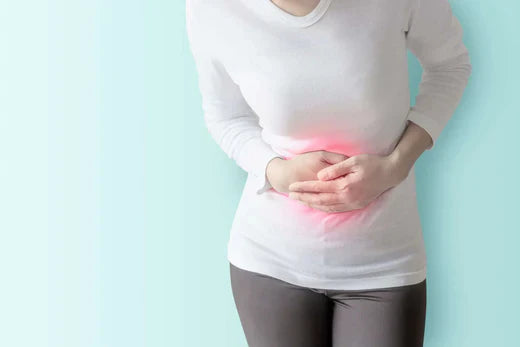A balanced diet helps the body obtain the nutrients it needs to work properly. It also aids in preventing disorders and non-communicable illnesses (WHO, 2018). Read on to learn why a diet is particularly important during menopause and how you can integrate it into your daily life. Firstly, let’s break down the essentials of a balanced diet. It includes macronutrients (carbohydrates, fat, and protein) and micronutrients (vitamins and minerals), as well as water (Alzate, 2019). Moreover, the most important trait in a healthy diet is including varied food in recommended serving sizes.
Why is it important to have a balanced diet?
In a nutshell, a balanced diet is important because it provides everything your body needs to work effectively. Without good nutrition, your body is more likely to develop different ailments. Some examples include infections, fatigue, tiredness, and low performance (Krans, 2020). Let’s take a closer look at where poor nutrition can lead to. A deficient diet is one of the leading health risks for people everywhere (WHO, 2018). Some of the main issues related to it are (SA Health, n.d.):
- Excess weight and obesity.
- Tooth loss.
- High blood pressure.
- High cholesterol.
- Heart disease.
- Type 2 diabetes.
- Osteoporosis.
- Cancer.
- Depression.
So, how can you achieve a balanced diet? The exact composition varies from person to person depending on their age, sex, lifestyle, and level of physical activity (WHO, 2018). As a result, nutritional requirements are different during perimenopause and even during the postmenopause period. In fact, tending to nutritional needs during menopause is key. Why? Because diet and physical activity are pivotal in managing the changes that begin in perimenopause (Vilaplana, 2016).

The role of food during menopause
Proper nourishment has the power to protect your body from illnesses that can develop during the perimenopause stage. This is the case for bone mass loss (that can lead to fractures) due to lower feminine hormones, among other causes. Furthermore, perimenopause is associated with weight gain and its correlated health risks. Hence, a balanced diet may contribute to preventing conditions such as (Alzate, 2016; Lewin, 2021; OASH, 2018):
- Osteoporosis and bone disorders like osteopenia.
- Mood alterations like anxiety, depression, irritability, and aggressiveness.
- Heart disease.
- Diabetes.
- Dry skin.
- Hot flashes.
- Vaginal issues and infections.
- Sleep difficulties.
- Memory and attention issues.
Healthy food can help improve or worsen the quality of life during perimenopause.
How to follow a balanced diet during menopause
These are some key recommendations to keep a balanced diet during menopause.
Include more legumes and nuts
Legumes, nuts, and seeds (like sunflower and chía seeds, for example) are a great source of nutrients. Some vital nutrients you need include (European Comissión, 2012; Mayo Clinic, 2020; Agarwal, 2014):
- Vitamin B6 helps regulate hormones, improving your mood as well as some menopause symptoms.
- Vitamin B3 contributes to skin health. It also keeps mucous membranes (like vaginal tissue) healthy.
- Vitamin C boosts iron absorption and collagen and antioxidant formation. There is also evidence that vitamin C helps increase estrogen levels, which usually decrease during menopause and are responsible for hot flashes and states of fatigue.
- Vitamin D is central to calcium absorption and to avoid bone mass loss –thus useful in preventing osteoporosis.
- Iodine aids the normal performance of the nervous system. It also contributes to thyroid-hormone production, which fights hypothyroidism –a common illness during menopause.
- Omega 3 works toward heart health and maintaining steady cholesterol levels.
Select your protein
Any balanced diet must include protein. During perimenopause and menopause, you can favor certain animal protein sources, like turkey, salmon, trout, and sardines. Protein contains iron, omega 3, and tryptophan, which help protect heart health and improve your mood and quality of sleep. Cottage cheese, oatmeal, and legumes like lentils, garbanzo beans, and black beans are a good source of healthy fat and tryptophan (Lewin, 2021; Levine, 2021).
Befriend phytoestrogens
Phytoestrogens are compounds that aid in achieving hormonal balance in the body. They can be found in plants. A diet rich in phytoestrogens can lessen the intensity of hot flashes –even making them disappear. Similarly, they help in controlling night sweats. You can find phytoestrogens in (Lewin, 2021):
- Soy milk and soy flour.
- Sunflower, sesame, and flax seeds.
- Tofu and tempeh.
- Celery and other food products in a plant-based diet.
The power of fruits and vegetables
Regularly eating considerable quantities of fruits and vegetables is one of the pillars of a balanced diet that deserves special attention. They burst with vitamins and minerals like vitamin E, D, A, C, and K, zinc, magnesium, calcium, and boron. That is why the World Health Organization (WHO, 2018) recommends having five servings of fruits a day, for example. These are some of the main benefits of eating fruits and vegetables during perimenopause (Lewin, 2021; Levine, 2021):
- Preventing bone conditions and disorders.
- Reducing the risk of heart disease.
- Decreasing inflammation and free radicals in the body.
Additionally, fruits and vegetables are an excellent source of fiber, which is advised during perimenopause. Fiber can help your organism absorb other substances it needs. Specifically, it may (Upham, 2021; Johnson, 2020; Mayo Clinic, 2021):
- Relief menopause symptoms like mood swings, thanks to mood-regulating isoflavones.
- Reduce diabetes and breast cancer risk by regulating blood sugar and decreasing high estrogen levels.
- Maintain a healthy weight.
The recommended daily intake of fiber is 21 grams. Some of the fruits and vegetables with high fiber content are:
- Steamed broccoli.
- Steamed green peas.
- Baked potatoes with their skin.
- Steamed sweet corn.
- Raw carrots.
- Raspberries.
- Pears.
- Apples.
- Bananas.
- Oranges.
- Strawberries.
Other considerations for keeping a balanced diet
On top of the previous considerations, aim to lower your red meat and processed food intake. The same goes for salty and sugary products. Food of this kind contains non-healthy fat, phosphorus, and sodium, which in excess may accelerate the loss of essential nutrients. In turn, this stimulates the onset of illnesses (Lewin, 2021; Levine, 2021; Johnson, 2020). Moreover, remember to drink plenty of water daily to control menopause symptoms. It reduces vaginal dryness, improves dry skin, and reduces inflammation. In turn, not drinking enough water can lead to muscle cramps, overly dry skin, fatigue, and feeling confused. The rule of thumb recommends drinking eight glasses of water a day (Johnson, 2020; Levine, 2021). Lastly, complement a balanced diet with at least 30 minutes of daily physical activity. You should also curb caffeine and alcohol intake and avoid tobacco use. It is important to create all these habits as preparation during perimenopause so your organism can properly take and manage the changes that come with menopause itself.
References
Agarwal, A. (2014).
El papel de los antioxidantes en la menopausia. Nutri Facts. https://www.nutri-facts.org/es_ES/news/articles/el-papel-de-los-antioxidantes-en-la-menopausia.html Alzate, T. (2019).
Dieta saludable. Perspectivas en Nutrición Humana, 21(1). https://revistas.udea.edu.co/index.php/nutricion/article/view/339980/20794830 European Comissión. (2012).
Regulations. Official Journal of the European Union. https://eur-lex.europa.eu/legal-content/EN/TXT/PDF/?uri=CELEX:32012R0432&from=EN Food and Agriculture Organization
You May Also Like

JOIN US AND GET 10% OFF
Sign up to our newsletter to access free resources, advice and support.















